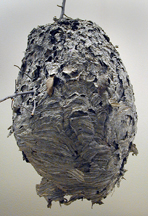
September 21, 2004
Purdue expert: patience is key when removing wasp nests
WEST LAFAYETTE, Ind. – Leaves are falling off trees, which means homeowners are more likely to see hornet and wasp nests hanging in their trees said Tim Gibb a Purdue Extension entomologist.

|
"People notice aerial nests much more in the fall, obviously because they're big, but also because the trees begin to lose their leaves," he said. "People look up and all of a sudden see a large football shaped, gray paper nest and think, 'Where did this come from?'"
Gibb said most people simply want to get rid of the nest, but some want to keep it.
"A lot of people this time of year ask about bringing wasp nests inside the home for a science project or for decoration," said Gibb.
In either case, his recommendations are the same. "It's best to let nature take its course."
Just like bees, wasps fill their nests with pollen and other materials they've collected to feed their larvae, Gibb said. The larvae are also in the nest. "It's not like these nests are just housing adult wasps," he said.
If a nest is brought inside before the wasps have a chance to clean it, the material inside will start to decay and smell. For that reason, Gibb suggests leaving the nests alone until after the first or second hard freeze when wasps naturally leave their nests.
"Leave them until after a couple of hard freezes if you can," Gibb said. "Because after the freeze the wasps are all going to be gone and when they leave they will clean out the nest."
Gibb said homeowners who simply want to dispose of a nest can throw it into the trash after the freeze.
"If you can't wait for a freeze, then be sure to use proper methods of control. A lot of people will want to use a stick or a broom or gasoline. That's just going to provoke the wasps, and somebody could get hurt. Use common sense and approved methods."
Basic control recommendations are:
• Spray insecticides at night, and wear adequate protective clothing with veil and gloves.
• A flashlight covered with red cellophane should be used when applying insecticide at night.
• Quick and accurate applications of pesticides are a necessity.
• Most above-ground and nearly all structural colonies are best handled by professional pest-control operators.
Recommendations for specific wasps and chemicals are available from Purdue Extension through a local Extension educator, or by calling Purdue Extension's toll-free helpline at (888) EXT-INFO (398-4636).
Information about controlling wasps and bees also is available online and https://www.entm.purdue.edu/Entomology/ext/targets/e-series/eseriespdf/e-44.htm
Writer: Kay Hagen, (765) 494-6682, kjh@purdue.edu
Source: Tim Gibb, (765) 494-4570, gibb@purdue.edu
Related Web sites:
Purdue entomology publications
Ag Communications: (765) 494-2722; Beth Forbes, forbes@purdue.edu
Agriculture News Page
PHOTO CAPTION:
Homeowners frequently find large wasp and hornet nests, such as this baldfaced hornet's nest, in their trees at the beginning on autumn. The nests have been there all year, but become visible once leaves fall from the trees. (Purdue Entomology photo/Al York)
A publication-quality photo is available.
To the News Service home page